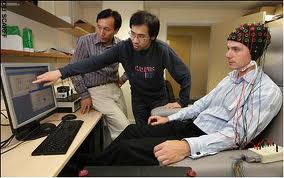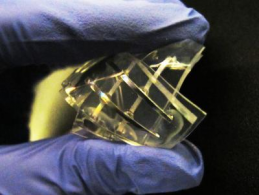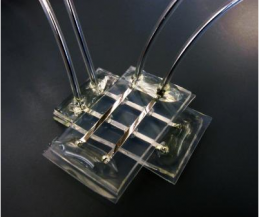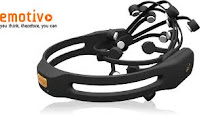Among gamers, Deus Ex is something of a legendary fusion of disparate gaming styles. Among science fiction buffs, Deus Ex is lauded for managing to take two awesome genres, William Gibson-esque cyberpunk and Robert Anton Wilson-level conspiracy theories, and jam them together into an immanentizing of the eschaton unlike anything you’ve seen since Doktor Sleepless. And among transhumanists, Deus Ex brought up every issue of humanity’s fusion with technology one could imagine. It is a rich video game.
So when Square Enix decided to pick up the reins from Eidos and create a new installment in the series, Deus Ex: Human Revolution (DX:HR), I was quite excited. The first indication DX:HR was not going to be a crummy exploitation of the original’s success (see: Deus Ex 2: Invisible War), was the teaser trailer, shown above. Normally, a teaser trailer is just music and a slow build to a logo or single image that lets you know the game is coming out. Instead, the development team decided to demonstrate that it was taking the philosophy of the game seriously.
What philosophy? you might ask. Why transhumanism, of course. Nick Bostrom, chair of the Future of Humanity Institute at Oxford, centers the birth of transhumanism in the Renaissance and the Age of the Enlightenment in his article “A History of Transhumanist Thought” [pdf]. The visuals of the teaser harken to Renaissance imagery (such as the Da Vinci style drawings) and the teaser ends with a Nietzschean quote “Who we are is but a stepping stone to what we can become.” Later trailers would reference Icarus and Daedalus (who also happened to be the names of AI constructs in the original game), addressing the all-too-common fear that by pursuing technology, we are pursuing our own destruction. This narrative thread has become the central point of conflict in DX:HR. Even its viral ad campaign has been told through two lenses: that of Sarif Industries, maker of prosthetic bodies that change lives, and that of Purity First, a protest group that opposes human augmentation. The question is: upon which part of our shared humanity do we step as we climb to greater heights?
Read rest of original article here
Quickly grabbing a cup of coffee is an everyday action for most of us. For people with severe paralysis however, this task is unfeasible - yet not "unthinkable". Because of this, interfaces between the brain and a computer can in principle detect these "thoughts" and transform them into steering commands. Scientists from Freiburg now have found a way to distinguish between different types of grasping on the basis of the accompanying brain activity.
In the current issue of the journal "NeuroImage", Tobias Pistohl and colleagues from the Bernstein Center Freiburg and the University Medical Centre describe how they succeeded in differentiating the brain activity associated with a precise grip and a grip of the whole hand. Ultimately, the scientists aim to develop a neuroprosthesis: a device that receives commands directly from the brain, and which can be used by paralysed people to control the arm of a robot - or even their own limbs.
One big problem about arm movements had been so far unresolved. In our daily lives, it is important to handle different objects in different ways, for example a feather and a brick. The researchers from Freiburg now found aspects in the brain's activity that distinguish a precise grip from one with the whole hand.
To this end, Pistohl and his collaborators made use of signals that are measured on the surface of the brain. The big advantage of this approach is that no electrodes have to be implanted directly into this delicate organ. At the same time, the obtained signals are much more precise than those that can be measured on the skull's surface.
The scientists conducted a simple experiment with patients that were not paralysed, but had electrodes implanted into their skull for medical reasons. The task was to grab a cup, either with a precise grip formed by the thumb and the index finger, or with their whole hand. At the same time, a computer recorded the electrical changes at the electrodes. And in fact, the scientists were able to find signals in the brain's activity that differed, depending on the type of grasp. A computer was able to attribute these signals to the different hand positions with great reliability. Now, the next challenge will be to identify these kinds of signals in paralysed patients as well - with the aim of eventually putting a more independent life back within their reach.
Source Bernstein Center Freiburg
In the current issue of the journal "NeuroImage", Tobias Pistohl and colleagues from the Bernstein Center Freiburg and the University Medical Centre describe how they succeeded in differentiating the brain activity associated with a precise grip and a grip of the whole hand. Ultimately, the scientists aim to develop a neuroprosthesis: a device that receives commands directly from the brain, and which can be used by paralysed people to control the arm of a robot - or even their own limbs.
One big problem about arm movements had been so far unresolved. In our daily lives, it is important to handle different objects in different ways, for example a feather and a brick. The researchers from Freiburg now found aspects in the brain's activity that distinguish a precise grip from one with the whole hand.
To this end, Pistohl and his collaborators made use of signals that are measured on the surface of the brain. The big advantage of this approach is that no electrodes have to be implanted directly into this delicate organ. At the same time, the obtained signals are much more precise than those that can be measured on the skull's surface.
The scientists conducted a simple experiment with patients that were not paralysed, but had electrodes implanted into their skull for medical reasons. The task was to grab a cup, either with a precise grip formed by the thumb and the index finger, or with their whole hand. At the same time, a computer recorded the electrical changes at the electrodes. And in fact, the scientists were able to find signals in the brain's activity that differed, depending on the type of grasp. A computer was able to attribute these signals to the different hand positions with great reliability. Now, the next challenge will be to identify these kinds of signals in paralysed patients as well - with the aim of eventually putting a more independent life back within their reach.
Source Bernstein Center Freiburg

 Virtual humans, both physical (robots) and online avatars will be added to the workforce. By 2020, robots will be physically superior to humans. IBM’s Blue Brain project, for instance, is a 10-year mission to create a human brain using hardware and software.
Virtual humans, both physical (robots) and online avatars will be added to the workforce. By 2020, robots will be physically superior to humans. IBM’s Blue Brain project, for instance, is a 10-year mission to create a human brain using hardware and software.  We have passed the threshold where more things than people are connected to the Net. The transition to IPv6 supports limitless connectivity. By 2020, there will be more than six Net-linked devices for every person on Earth. Currently, most of us are connected to Net full-time through three or more devices like PC, phones, TV etc. Next up are sensor networks, using low-power sensors that “collect, transmit, analyze and distribute data on a massive scale,” says Evans.
We have passed the threshold where more things than people are connected to the Net. The transition to IPv6 supports limitless connectivity. By 2020, there will be more than six Net-linked devices for every person on Earth. Currently, most of us are connected to Net full-time through three or more devices like PC, phones, TV etc. Next up are sensor networks, using low-power sensors that “collect, transmit, analyze and distribute data on a massive scale,” says Evans.
 Technology is finally adapting to us. Evans cites image recognition, puzzle resolution, augmented reality and gesture-based computing as key examples of such technologies.
Technology is finally adapting to us. Evans cites image recognition, puzzle resolution, augmented reality and gesture-based computing as key examples of such technologies. By 2020, one-third of all data will live in or pass through the cloud. IT spending on innovation and cloud computing could top $1 trillion by 2014.
By 2020, one-third of all data will live in or pass through the cloud. IT spending on innovation and cloud computing could top $1 trillion by 2014.  How are all networked devices going to be powered, and who or what is going to power them? The answer, says Evans, lies in small things. Solar arrays will become increasingly important.
How are all networked devices going to be powered, and who or what is going to power them? The answer, says Evans, lies in small things. Solar arrays will become increasingly important. 
 March 2010: Retina implant restores vision to blind patients.
March 2010: Retina implant restores vision to blind patients.
























